 I continue to sojourn on with my 2020 Resolution Project, tackling two great Netflix animated series, starting with Voltron: Legendary Defender. We’re already up to the third season, and if you need some refreshers, take a look at my breakdowns of Seasons One and Two.
I continue to sojourn on with my 2020 Resolution Project, tackling two great Netflix animated series, starting with Voltron: Legendary Defender. We’re already up to the third season, and if you need some refreshers, take a look at my breakdowns of Seasons One and Two.
I’m not exaggerating when I say these are breakdowns — I’m not just covering the season on the whole, but discussing animation, acting, plot, character, and more in a spoilerific, expansive review. Consider this a deep-dive into the Voltron galaxy and relive all of the things you know and love about Legendary Defender!
The Premise:
DreamWorks’ Voltron Legendary Defender picks up immediately following the events of Zarkon’s defeat as the Paladins struggle to recover with one of their own missing, leaving them unable to form Voltron. The team must quickly devise a plan as the ascension of Prince Lotor threatens to bring chaos to the entire universe. Only by coming together, not just as Paladins but with the freedom fighters liberated from Galra occupation, will they be able bring the fight to their most formidable enemies yet.
Discussion: The very last images Season Two left us with were Shiro’s empty Black Lion, Zarkon unconscious and near death, and Haggar calling for Prince Lotor — a triple-threat of impactful moments that here on out change the game for our heroes. With so many questions unanswered at the end of Season Two, does Season Three satisfy?
Spoilers below!
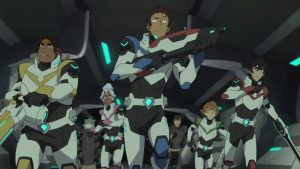 Story: Season Three is pretty heavy on the plot and exposition, but we’ve reached the point where mysteries have to be solved and questions must be answered to prepare for the heavy-hitting stuff coming forward. The battle with Emperor Zarkon is over, but that doesn’t mean the Galra Empire is a done deal. That doesn’t un-conquer faraway planets and peoples. It doesn’t erase thousands of years of murder, destruction, and subjugation. I think that’s one of the key themes of this season: once the weapons are put away, what other tools can you use to rebuild the bridges between these people? It’s a solid question to ask, and I think that’s one of the fascinating points about this season. To drive this point home — that “[…] we can’t always put the fate of the universe in the hands of a giant weapon” — Voltron is literally out of commission without a Paladin operating the Black Lion, so our heroes must continue to fight for the good of the universe in new, unfamiliar ways.
Story: Season Three is pretty heavy on the plot and exposition, but we’ve reached the point where mysteries have to be solved and questions must be answered to prepare for the heavy-hitting stuff coming forward. The battle with Emperor Zarkon is over, but that doesn’t mean the Galra Empire is a done deal. That doesn’t un-conquer faraway planets and peoples. It doesn’t erase thousands of years of murder, destruction, and subjugation. I think that’s one of the key themes of this season: once the weapons are put away, what other tools can you use to rebuild the bridges between these people? It’s a solid question to ask, and I think that’s one of the fascinating points about this season. To drive this point home — that “[…] we can’t always put the fate of the universe in the hands of a giant weapon” — Voltron is literally out of commission without a Paladin operating the Black Lion, so our heroes must continue to fight for the good of the universe in new, unfamiliar ways.
We’re dealing with episodes containing major transformations, upheavals, and changes, and we finally get some key information that blows everything wide open, therefore making Season Three both satisfying and…quite busy! We also have the continuation of the theme established in earlier seasons — nothing and no one can be judged at face value.
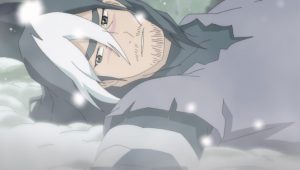 Characters: This season’s MVPs are Shiro, Prince Lotor, Allura, and Lance, in terms of characterization and their times to shine. Of course, the other characters have their moments, but there’s deeper stuff going on here with each of these players that make them the standouts of Season Three.
Characters: This season’s MVPs are Shiro, Prince Lotor, Allura, and Lance, in terms of characterization and their times to shine. Of course, the other characters have their moments, but there’s deeper stuff going on here with each of these players that make them the standouts of Season Three.
I am someone who falls heavily for someone who undergoes great suffering, and Shiro is that character in Voltron: Legendary Defender. We find out in Episode 5 (“The Journey”) what’s happened to Shiro all this time — captured by the Galra (again), experimented on (again), and escaping them (again). But this time, it’s much darker and more disturbing…and then his escape is filled with so many setbacks, brushes with death and pain, and great losses one right after the other. Shiro is put through the wringer in Episode 5 and he really proves his mettle, endurance, and leadership from here on out through the final episodes. What a character!
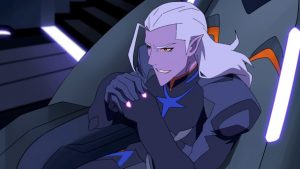 Season Three also introduces my favorite character, Prince Lotor. We really only get a surface look at him this season, and he is mostly an enigma where he’s so charming, you can’t quite tell if he’s totally evil. There are moments where it’s quite clear he is (when he is cold and duplicitous), but then his insistence that he does not want to subjugate people or be anything like his father makes you see hope for him. Despite these glimmers, you can still see that Lotor is a villian with a capital “V” this season, but there’s definitely more going on than meets the eye. That mystery, that noble accent, and his impressive character entrance at the gladiator arena in Episode 1 (“Changing of the Guard”) make him a valuable player this season.
Season Three also introduces my favorite character, Prince Lotor. We really only get a surface look at him this season, and he is mostly an enigma where he’s so charming, you can’t quite tell if he’s totally evil. There are moments where it’s quite clear he is (when he is cold and duplicitous), but then his insistence that he does not want to subjugate people or be anything like his father makes you see hope for him. Despite these glimmers, you can still see that Lotor is a villian with a capital “V” this season, but there’s definitely more going on than meets the eye. That mystery, that noble accent, and his impressive character entrance at the gladiator arena in Episode 1 (“Changing of the Guard”) make him a valuable player this season.
Allura really has some great moments this season, too. While she’s always been a strong force for Team Voltron, we get to see her become the Blue Paladin, be tempted by the alternate-reality Alteans in Episode 4 (“Hole in the Sky”), prove to be a genuine challenge for Prince Lotor (the girl’s a natural!), and we see even more character development from her.
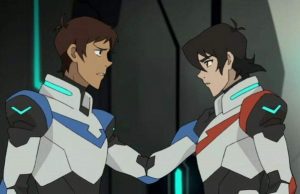 Lastly, Lance becomes even more redeeming and humble this season, which explains his well-deserved upgrade to the Red Lion. I have not always been a fan of Lance — I don’t like all the womanizing, star-in-the-smile jokes — but as he continues to question his place with the Paladins (a continuation from last season), we get to see some genuine vulnerability and maturity come from him. In Episode 2 (“The Red Paladin”), Lance is one of the first to accept Keith is the new leader of Voltron as the Black Paladin, despite his own desire to lead:
Lastly, Lance becomes even more redeeming and humble this season, which explains his well-deserved upgrade to the Red Lion. I have not always been a fan of Lance — I don’t like all the womanizing, star-in-the-smile jokes — but as he continues to question his place with the Paladins (a continuation from last season), we get to see some genuine vulnerability and maturity come from him. In Episode 2 (“The Red Paladin”), Lance is one of the first to accept Keith is the new leader of Voltron as the Black Paladin, despite his own desire to lead:
Keith, no one can replace Shiro. But the Black Lion wouldn’t choose anybody it didn’t feel was worthy to lead Voltron. I respect its choice. And you should too.
Animation: We’ve got a lot of cool set pieces this season — for example, the mysterious, stormy planet Thayserix in Episode 3 (“The Hunted”) is where the Paladins are split up and lured into a trap by Prince Lotor, all due to Keith’s impulsivity and recklessness as Voltron’s new leader. Another great set piece is Daibazaal, the original home of the Galra and the source of an inter-reality gate used to harbor quintessence. Daibazaal became unstable due to the gate, and in the massive reveal in the final episode of the season (“The Legend Begins”), we learn that Princess Allura’s father, King Alfor, destroyed the planet to close the rift.
And once again, I’m a sucker for the animation leveling up whenever there are hand-to-hand combat scenes. The choreography is excellent and I love how everything flows together. Here’s an example with Prince Lotor fighting in the gladiator arena (look at that head of hair!):

Voice Acting: A.J. Locascio really nails Prince Lotor’s voice, with a charismatic but cold demeanor coupled with a noble British accent. Steven Yeun once again does a great job with Keith whenever he’s hurt, angry, frustrated…and the same thing with Kimberly Brooks, who voices Princess Allura — I really enjoyed her emotional performances this season. My last kudos goes to Neil Kaplan, who plays Emperor Zarkon…in the season finale, where we see an uncorrupted Zarkon before he overdoses on quintessence, you can hear the same voice actor performing, but it sounds like two different people entirely. That’s some acting chops right there.
Low Points of the Season: I really struggled to find a low point this season. There was so much going on and I enjoyed this season immensely, but if I had to choose something, it would be Sven’s unfortunate pseudo-Scandinavian accent in Episode 4. But I can’t be too hard on voice actor Josh Keaton, who admitted that he wasn’t told about Sven or his accent until the night before he had to perform — that’s a pretty big surprise!
High Points of the Season: …Within the same episode, I have to say Sven’s presence is pretty funny, because he’s a shout-out to the original Voltron: Defender of the Universe (aka the 1984 series) and this is an obvious Easter egg for all Voltron fans. Sven was the Norwegian pilot of the Blue Lion from the 1984 Voltron, and I don’t want to reveal more than that because the parallels between the first Voltron and Voltron: Legendary Defender make things spoilery for future seasons, even though things play out differently. Anyway, just like with Lotor, look at that head of hair!
Other high points of the season include the changing of the lions, Shiro’s return, and the season finale, which reveals SO MUCH important information: how Voltron was created; that quintessence is “life itself;” who Haggar is (the Altean scientist Honerva, later Zarkon’s wife!); how Zarkon and Honerva became evil; etc. It was an excellent way to close out the season, all the while leaving enough mystery to propel you forward into Season Four.

Final Thoughts: We now know so many tragic things about the original Paladins of Voltron, and we’re one step further into the theme that things aren’t what they seem. In the alternate reality in Episode 4, we see Alteans who subjugate just like the Galra, but in a slightly different way — a type of surgery that removes free will, which makes everyone “peaceful” (lobotomies in space!). We see the possibility that Alteans, long believed to be the noble people in the universe and the good guys (because Allura and Coran are awesome), can be capable of great evil, as they threaten to “spread our peace to every reality.” And we see it again when we learn that King Alfor destroyed Daibaazal, the Galra home planet, which serves as fuel for Zarkon’s revenge and the retaliative destruction of the planet Altea. As Keith tells Allura in Episode 4, “It wasn’t that long ago that we thought all Galra were bad. Maybe things aren’t as black and white as [they’re made] out to be.” I love that this is a theme sewn into every season of Voltron: Legendary Defender. I also continue to stand by my Season Two assessment that the writers of this Voltron seem to be playing the long game — there is so much incredible character foreshadowing, especially for Seasons 7 and 8. Whether it was a happy accident or the result of careful planning, either way, I’m impressed.
See you next time for my breakdown of Season Four!


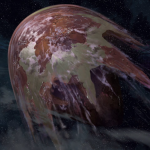

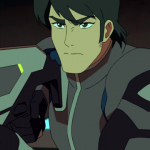
No Comments